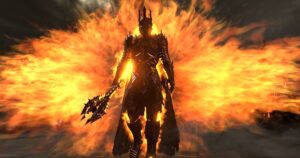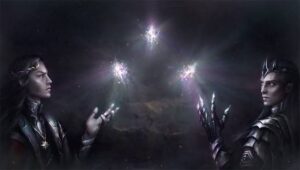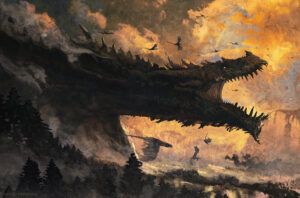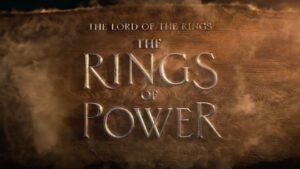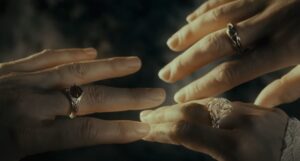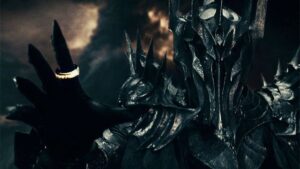POTENTIAL SPOILERS FOR THE RINGS OF POWER AHEAD!
Three years ago, in February 2019, the official Twitter account for what was then known merely as ‘The Lord Of The Rings on Prime’ posted their very first tweet, heralding the release of a series of official maps. Three years and one pandemic later, we’re just a few days out from the Super Bowl, and what could potentially be another milestone in The Rings Of Powers‘ long and epic journey – the release of a teaser trailer. And to celebrate the occasion, Amazon dropped twenty-three new character posters on Thursday, each bearing the series’ title and an image of a character’s hands – drawing attention to their respective weapons of choice, various accessories, and of course, lots and lots of rings.
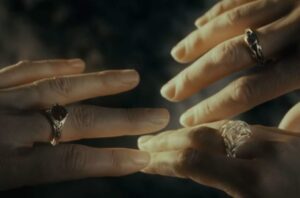
Some would argue that Amazon is just giving us crumbs of content, not even telling us the names of the actors and characters depicted in these posters, but I’ve watched our fandom support itself on literal crumbs throughout most of 2020 (that was a dark time), and this…this is a four-course meal and dessert compared to what Amazon used to post on their social media outlets. I say that as someone who’s had Twitter notifications for The Rings Of Power turned on for the last three years in preparation for a day such as today.
Luckily, I also had Twitter notifications turned on for most of the prominent Tolkien scholars, community leaders, and fan accounts to whom Amazon actually entrusted the task of revealing each new poster. I won’t lie, it was hectic trying to keep up with who was posting what and when, but it was also fun, and I deeply appreciate that Amazon gave the fans a chance to help promote The Rings Of Power and boost their own profiles in so doing instead of releasing these posters through the usual Hollywood trades or through their own social media.
And now we have twenty-three new character posters to pore over, so let’s get into this, shall we? They might not have names attached to them, but the subtle clues and in-universe cultural influences layered into the costuming and accessories make it surprisingly easy to break down the posters into five mostly distinct groups: Elves, Humans, Hobbits, Dwarves, with just one or two outliers that don’t fit neatly into any category. I’ll sprinkle more of my overarching thoughts regarding the costumes and costume design into the post, but if you don’t have any intention of reading further let me just tell you now: the costumes look gorgeous.
If it’s costume designer Kate Hawley who’s the mastermind behind the costumes showcased in these posters, each worthy of being put on display in a museum after their time in the spotlight is done, then Rafe Judkins really needs to hit her up now that The Wheel Of Time‘s costume designer Isis Mussenden has left the series. I had many criticisms of The Wheel Of Time‘s costume design and production design overall, but what disappointed me the most was the lack of richness, patterning, texture, and intricacy that I see in The Rings Of Power‘s costumes (granted, The Wheel Of Time had a much smaller budget).
Something that has been carried over from The Wheel Of Time is a bold approach to color, but the diversity of fabrics and materials (as well as better lighting) makes all the difference. Any crowd scene on the busy streets of Númenor or deep within the echoing caverns of Khazad-dûm is sure to be a treat for the eyes, and I’m very excited to see how these costumes look in action, and how the actors wear them. They make excellent hand-models, but I want to see them swishing and swooshing and strutting their stuff in that trailer, whenever it comes.
With all that out of the way, it’s time to speculate.
Elves
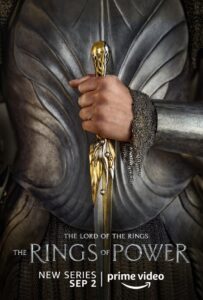
Let’s start with an easy one. I agree with the general consensus on Twitter that this poster depicts Morfydd Clark as Galadriel, wearing silver armor over a chainmail shirt and carrying a unique (and instantly iconic) sword, the hilt of which is fashioned to resemble the Two Trees of Valinor that once grew in paradise, welded into one. Its canopy of gold and silver leaves forms the round pommel of the sword. That alone implies that the wielder is one of the High Elves who came out of paradise during the First Age, which would line up with Galadriel’s canonical backstory. She is one of the few Elves left in Middle-earth who remembers Valinor and its glory.
She was also described by J.R.R. Tolkien as a proficient military strategist, and Amazon appears to be expanding on that by giving her a practical suit of armor befitting a commander of troops in the War of the Elves and Sauron. This would seem to confirm one of the earliest rumors regarding The Rings Of Power, that Galadriel would be depicted as a hardened warrior still fighting a war that had ended for most of her comrades, and would lend credence to other character details found in the audition tapes that sparked those rumors.
One last thing before we move on; the silhouette of this armor seems intentionally designed to evoke images of the Second Age Elves seen in the prologue to The Fellowship Of The Ring, which makes sense given that those Elves, with their distinctive cuirasses, helmets, and shields, more effectively convey to the general audience that this is a prequel series than any lengthy explanation of Middle-earth’s timeline could – that and another immediately recognizable ancient suit of armor, which we’ll get to near the end of this post.
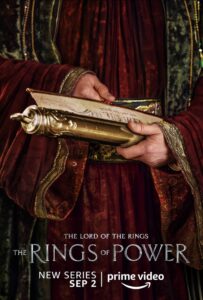
Although this character’s heavy robes in dark shades of red and green could be of either Elven or human make, the Tengwar writing on the edge of the scroll gives away a clue that this is most likely an Elf – possibly even Elrond, who was no less bookish and introspective in the Second Age than he was in the latter half of the Third, and lived in King Gil-galad’s court as a royal herald before establishing Rivendell as a safe haven for poets, artists, philosophers and historians. Elrond is believed to be played by Robert Aramayo, and these could certainly be his hands.
I spent an embarrassing amount of time studying hands trying to match the twenty actors in Amazon’s main series cast to the twenty-three pairs of hands we see in these posters, and in only a few cases could I be absolutely certain who I was looking at. I’m not even certain this character is actually an Elf and not simply a human who can read Tengwar, in which case they could very well be a Númenórean Elf-friend – perhaps Elendil or someone of his house.
According to Tengwar Teacher on Twitter, the writing on this scroll translates to “King’s Scroll – View from South“. Above it is drawn a picture of a bridge leading to a door flanked by two trees, presumably viewed from the south. My mind immediately leapt to the famous Doors of Moria, which stood open throughout most of the Second Age to welcome any travelers, and that’s the only location in Middle-earth I can think of that canonically fits this description, so I’m going with the theory that Elrond is busy reviewing a report of what Celebrimbor and his Elves have gotten up to in Eregion.
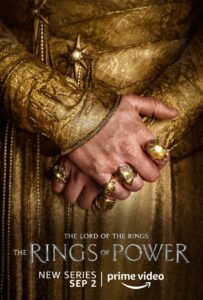
Speaking of Celebrimbor, there’s no other character in Middle-earth who would wear the eight-pointed Star of the House of Fëanor so proudly (and to be honest, so loudly) on their clothes. The last of Fëanor’s bloodline and second only to Fëanor himself in artistry and craftsmanship, Celebrimbor is a pivotal figure in the Second Age, overseeing the creation of the Rings of Power and many other great works in the city of Ost-in-Edhil and in the neighboring Dwarven kingdom of Khazad-dûm, with whose inhabitants Celebrimbor enjoys a mutual friendship.
This character, draped entirely in shimmering gold fabric, wears several golden rings on his fingers – which I’m willing to bet are among the countless lesser rings that Gandalf described in The Lord Of The Rings as “essays in the craft”, being just dangerous enough that you wouldn’t want anyone but an Elf wearing one for any length of time, but not so dangerous that they could possibly cause the end of the world. But it’s the Dwarven runes embroidered on this character’s sleeves that really seal the deal for me. This has to be Celebrimbor.
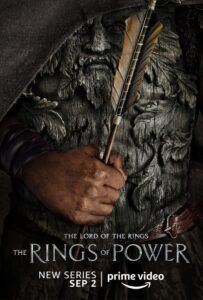
This is a fascinating poster. The character grips a feathered arrow, the preferred weapon of the Silvan Elves who dwelt in Mirkwood and Lórien, and wears a gray cloak like the ones gifted to the Fellowship of the Ring by the Elves of Lórien. But my eye was immediately drawn to that face – no, not the character’s face, for that is hidden, but the face carved into this character’s black wooden breastplate. With a signature frown, heavy brows, and beard and wild hair inseparable from the swirling leaves surrounding him, this is unmistakably the Foliate Head of the Green Man.
But what is the Green Man, an archetypal character from mythology primarily found carved into the walls of English churches and other old buildings, doing in Middle-earth? I can think of three reasons. If this is indeed a Silvan Elf depicted in this poster, then perhaps the Green Man is merely being used in his original pagan function: as a visual metaphor for the ecstasy and freedom that comes from casting off the constraints of society and achieving equilibrium with nature. The Silvan Elves, particularly those we see in The Hobbit, celebrate their liberated state with banquets and parties in the woods, heavy drinking, and a dismissive attitude towards the rest of the world.
Alternatively, there’s a chance this face represents either Tom Bombadil or an Ent, as both are believed to have been partly inspired by the legends of the Green Man. The Ents, with their long leafy beards and gnarled faces, share obvious similarities with the physical description of this enigmatic mythological figure. As for why one would be carved on a Silvan Elf’s breastplate, the answer lies in Legolas’ comments about the Ents in The Lord Of The Rings, where he talks about how the Silvan Elves have long been reverent of the mysterious shepherds of the trees who successfully withdrew into the depths of Fangorn Forest.
In the early Second Age, Sindarin and Noldorin Elves from Beleriand came to Middle-earth and established kingdoms and cities on lands that had once belonged to the Silvan Elves, leading to some strife and unrest between the two peoples – although most of the Sindarin Kings like Oropher (grandfather of Legolas) and Amdír adopted the Silvan language and culture, and their peoples became one. As no Silvan Elves are named in Tolkien’s chronicles of the Second Age, the figure in this poster could be either Oropher or Amdír, or it may be an original character – a Silvan Elf rebel, perhaps, who wears the Ent face as a symbol of resistance to Sindarin rule?
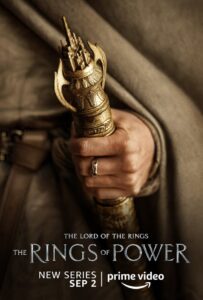
This poster confused me when I first saw it, and it still confuses me now. The character wears a gray cloak oddly reminiscent of the one worn by Gandalf in The Lord Of The Rings, but carries an ornate golden scepter topped with an incredibly detailed sculpture of a city with little towers and turrets and walls. Typically, only a king would carry such a scepter, but this outfit seems too plain for a king’s wardrobe, somehow. The ostentatious kings and queens of Númenor would never be caught dead without some priceless jewels or accessories on their person, and one itty-bitty silver ring isn’t gonna cut it.
But then I saw a post on Reddit from a keen-eyed Tolkien fan pointing out the similarities between the sculpture on this scepter and Alan Lee’s paintings of Gondolin, and now I can’t unsee it. The placement of the towers, the distinctive series of gates and stairs, it all lines up perfectly. Now, that doesn’t necessarily mean this character is from Gondolin – after the city was sacked at the end of the First Age, many of its treasures were lost and scattered across Middle-earth by orcs, thieves, and fleeing refugees. Most notably, the swords Glamdring, Orcrist, and Sting turned up thousands of years later in a troll’s cave.
But somehow I doubt this scepter would be put front-and-center in a character poster if it didn’t have meaning to the character holding it, which leads me to my theory that this is either Elrond, whose father Eärendil was born in Gondolin shortly before its fall, or Glorfindel, a warrior prince of Gondolin who actually died defending a group of refugees from a Balrog but was sent back to Middle-earth in the Second Age (long story) to help the Elves fight Sauron. He remained there until the end of the Third Age, although he’s been left out of every film adaptation of The Lord Of The Rings.
In Ralph Bakshi’s animated adaptation, his crucial role in carrying an injured Frodo Baggins to Rivendell was filled by Legolas (which is especially weird given that Legolas isn’t even from Rivendell), while Peter Jackson swapped him out for Arwen, only to sideline her for the rest of the trilogy. But Glorfindel might just get the last laugh, because I could easily envision a scenario where he fills the Gandalf role in The Rings Of Power, organizing the resistance to Sauron, rallying troops, and inspiring a new generation of heroes to take up the fight. The two characters have a lot in common – starting with the fact that they both got killed by a Balrog and resurrected by the gods.
Humans
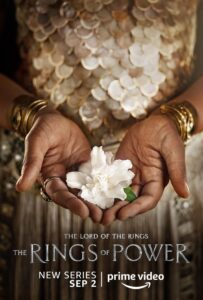
Of all the character posters revealed, and there were a great many, none is more beautiful to me than this one, which gives us our first look at what I believe to be actress Cynthia Addai-Robinson as Tar-Míriel, the only child of King Tar-Palantir and the last Queen of Númenor. Dressed in a shimmering pearlescent tunic and adorned with gold, the Queen clasps in her hands a small white flower – likely a blossom of the White Tree that grew once upon a time on the palace grounds of Armenelos in Númenor. The flower may have hidden significance, as Tar-Palantir’s Adûnaic name, Inziladûn, translates to “Flower of the West”.
According to a production sheet unearthed back in November, the legitimacy of which is still unproven, Tar-Palantir is alive but very old when The Rings Of Power opens, and I have a strong feeling that Tar-Míriel is already ruling Númenor in his stead as a regent during these final months or years of his life, anxiously waiting for him to pass on and relinquish the throne so she can enact her own plans to prevent the corruption of Númenor by her father’s political advisors, who in full view of Tar-Míriel are gathering support for a coup.
The acceptance of mortality, death, and the eventual decay of all things is an overarching theme of the Second Age and of Middle-earth in general, but to see it through the eyes of a woman torn between her love for her father and her responsibility to her people would be extremely ambitious and impactful. My sneaking suspicion is that the pure white flower Tar-Míriel clasps in her hands in this beautiful image represents her father’s life, which she will hold in her hands at some point in season one.
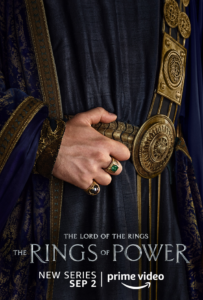
I believe this character, whom we see with one hand resting confidently on their large golden belt, is most likely Trystan Gravelle as Ar-Pharazôn, whom Fellowship Of Fans exclusively reported back in December would primarily be seen wearing blue and gold, the colors of Númenor. That report provided numerous interesting details about Ar-Pharazôn’s role in The Rings Of Power, including confirmation that in season one he is still referred to simply as Pharazôn, having not yet usurped the throne from Tar-Míriel and declared himself king of Númenor.
Throughout the first season, Pharazôn is rumored to serve as Tar-Míriel’s closest advisor and confidante, which will make his betrayal of her all the more poignant. My guess is that Pharazôn will pretend to help Tar-Míriel deal with her father’s other greedy political advisors, only to secretly form alliances with them behind her back and organize them into a unit actually capable of bringing her down once she finally succeeds to the throne. Time will tell if fans will also be deceived by his lies.
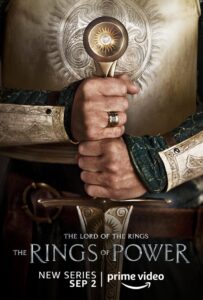
The vivid sea-green fabric beneath this character’s faded golden armor tells me that this is probably a Númenórean, and a high lord at that. Judging by the hands, it’s not Maxim Baldry as Isildur, but it could be Lloyd Owen as Elendil, Isildur’s father and the Lord of Andúnië in the late Second Age. Elendil appeared for just a few seconds in the prologue to The Fellowship Of The Ring, before being slammed in the chest with Sauron’s mace and tossed several feet into the air, dying instantly.
In that scene, the focus wasn’t on Elendil but on Isildur, who famously took up the hilt-shard of his father’s sword that had been crushed beneath him when he fell, and cut the One Ring from Sauron’s hand, temporarily defeating the Dark Lord. I assume that sword, Narsil, is what we see in this image – although it looks very different from the version of Narsil designed for Peter Jackson’s films, which strongly suggests that Amazon is moving in their own direction with The Rings Of Power. The blade we see here actually evokes the description of Narsil reforged in The Lord Of The Rings, with “a device of seven stars set between the crescent Moon and the rayed Sun”.
The rayed sun also appears on the pommel of the blade and on Elendil’s breastplate, which might have no significance at all but after writing at length about how Men were born with the first dawning of the Sun I couldn’t help but notice the repetition of this motif and file it away under things that warrant further investigation. It might have something to do with the persecution of Elf-friends like Elendil by other Númenóreans during the late Second Age. Is Elendil trying to say that he is still a human Man first and foremost, despite being the most prominent Elf-friend in Númenor?
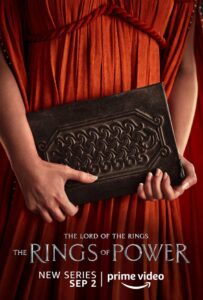
I’m still not certain if these are Ema Horvath or Nazanin Boniadi’s hands, but I think what’s obvious from the tidily manicured fingernails and the elegant orange dress is that this character is someone very well-to-do. She carries a journal of some kind with a wavy pattern embossed on the cover, something that we see repeated in the costumes I believe to be of Númenórean make, which leads me to believe this is a Númenórean woman from a noble family, perhaps even Isildur’s sister, Carine – an original character created by Amazon whom we’ve heard about from Fellowship Of Fans.
Ema Horvath is tentatively attached to the role of Carine, who appears to have gone by the code-name “Shay” at one point. It was Shay who was described in character breakdowns obtained by Knight Edge Media as a “pragmatic…studious…politically minded” woman who acts as “a peacekeeper” for her entire family in times of political crisis. She’ll have her work cut out for her in the late Second Age, that’s for sure.
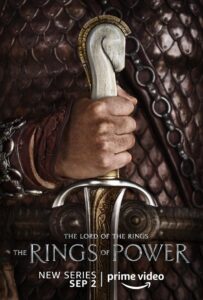
This poster caused a stir on Tolkien Twitter when it was revealed because at a first glance, it instantly conjures up images of Rohan, a kingdom that wasn’t founded in the Second Age and wouldn’t be for another few thousand years. But as my sister pointed out to me first, the horse on this character’s sword is actually a seahorse, implying that they’re Númenórean rather than a member of the Rohirrim. They wear a very similar long-sleeved shirt under their armor to the one Elendil wears under his, even bearing the same rippling pattern, although this character’s clothes are brownish-red.
The muted color palette, especially in comparison to the vivid sea-green worn by Elendil, makes me think this character is lower-ranking than the Lord of Andúnië. The one hand visible looks like it could belong to actor Alex Tarrant, whom Fellowship Of Fans has previously linked to the role of one of Isildur’s close friends. Extrapolating from that, this character could have met Isildur and befriended him if the two were both lieutenants under Elendil. He must be significant, however, if he is deserving of his own character poster.
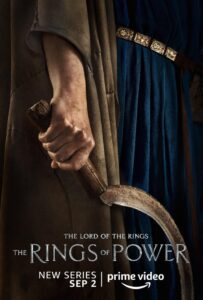
I love this poster because it gives me the vibes I want from The Rings Of Power. I look at this, and I’m immediately transported back to the Bronze Age, which is exactly what the Second Age should feel like in comparison to the vaguely Medieval aesthetics and technologies of the late Third Age, when The Lord Of The Rings takes place. The vibrant blue dress, the simple golden belt, that wicked looking sickle…it’s just really cool. I’d wager this character is human, most likely a woman from the lands of Middle-earth under Númenórean control.
The one character in The Rings Of Power who would fit that description is known only by the code-name “Kari”, and is believed to be played by Nazanin Boniadi, the highest-profile actress attached to the series (that we know of). Kari is a “self-sufficient single mother” according to the Knight Edge Media character breakdowns, who falls in love with someone from outside her village – someone “who the rest of the community may never accept”. Forbidden love is a classic and slightly overused trope in fantasy, but we’ll have to see if Rings Of Power can put a fresh spin on this story.
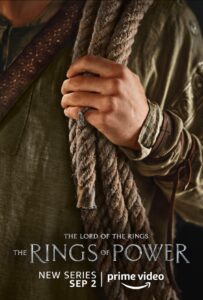
I probably would have accidentally categorized this character as a hobbit were it not for another perceptive Reddit user who figured out that the distinctive marks on the back of this person’s hands are shared by actor Maxim Baldry – who is believed to be playing none other than Isildur, the eldest son of Elendil and the man who would go on to establish the kingdom of Gondor in Middle-earth, defeat Sauron in the War of the Last Alliance, and take the One Ring from the Dark Lord’s hand only to lose it in the waters of the River Anduin.
This is a surprisingly humble costume for a character with such an epic destiny, but I’m once again going to credit my sister for laying out the most solid theory I’ve seen yet for why Isildur would be dressed in plain clothes, carrying the kind of rope typically found on sailing-ships. As she explained to me, the first audition tapes for Elendil – code-named “Loda” – actually presented us with all the puzzle-pieces upfront, but without the context that “Loda” is Elendil and his son “Cole” is Isildur (confirmed in circuitous fashion by Fellowship Of Fans and Redanian Intelligence), we couldn’t fit them all together at first.
In case you need a reminder, Elendil’s dialogue in one of those three-year old tapes revealed that he sees Isildur as a lost cause who is “[wasting] the most important years of his life on aimless schemes” and “hasn’t been home in three weeks”, which leads to an argument between him and his daughter – the aforementioned Carine – over which of them will finally reach out to him. In a second tape, Elendil tells an unnamed woman in passing that the “restless youths” of his land, including his eldest son, foolishly go looking for trouble in “the southern reaches” where there are “outlaw tribes”.
I have no idea what he might be referring to specifically, but all these comments taken together paint an interesting picture of a rebellious young Isildur traveling around Númenor looking for adventures, and probably cut off from his family’s fortunes. That would explain the simple clothes, and the ropes suggest to me that Isildur will look for his adventure on the high seas. He could travel east or south to the shores of Middle-earth, but he already seems like the type of guy who might even dare to sail westward, seeking out paradise and coming dangerously close to breaking the Ban.
Put into place at the beginning of the Second Age, the Ban prevents the Númenóreans from sailing “so far westward that the coasts of Númenor could no longer be seen”. This was intended to keep humans out of paradise, which at the time was still a physical place separated from Middle-earth and Númenor only by an ocean. The Númenóreans begrudgingly respected the Ban right up until the days of the last king, but The Rings Of Power would be wise to vividly illustrate the consequences of straying near the limit rather than simply telling the audience about this invisible barrier in the sea and expecting them to retain that information.
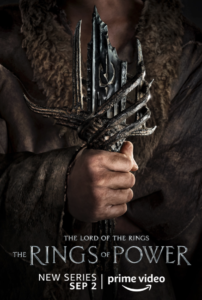
The only thing in this poster that gives away any clue as to the character’s identity is the distinctive sword they carry, which takes up most of the image and effortlessly draws attention from their simple brown traveling clothes lined with fur. Amazon clearly wants you to look at this sword, with its broken, gnarled blade inscribed with strange runes, attached to an overgrown hilt like a grasping iron claw with many fingers. They want you to dig out your copies of The Silmarillion and Unfinished Tales and search for clues.
And that’s exactly what Tolkien fans have done, with one theory quickly emerging that this is Anglachel – the sentient glowing black sword forged by the Dark Elf Eöl from a meteorite in the First Age, given as tribute to King Thingol of Doriath, removed from the treasure-hoards of Menegroth and carried into battle for the first time by Beleg Strongbow, taken from Beleg’s dead body by the tragic hero Túrin Turambar and reforged into Gurthang, and used by Túrin to slay the great dragon Glaurung and to end his own life after discovering that he had accidentally married his sister Nienor, at which point the blade finally broke into a million tiny pieces.
Few swords have as long a history as Anglachel, but The Silmarillion is pretty explicit that the sword’s shards were buried with Turin beneath the Stone of the Hapless, which was itself buried under ocean water when the sea rushed into Beleriand at the end of the First Age and forced Elves, Men, and Dwarves to flee further into Middle-earth. If this is indeed Anglachel, that would imply that someone removed the sword from Turin’s grave before the end of the First Age – and then what? Did they pass it on to their descendants, one of whom we see in this poster? But why?
Not to jump to conclusions or anything, but could this character somehow be a descendant of Túrin himself? Nienor, his sister and wife, threw herself from a cliff into the River Teiglin after learning the truth about their relationship, but although a grave was erected for her alongside Turin’s, her body was not found, and Tolkien notes that it was “[never] known whither the cold waters of Teiglin had taken her”. Could she have survived, and given birth to her child with Túrin? Maybe that’s a reach, but I’m just confused why anyone would willingly choose to carry Anglachel, a sword that was widely believed to have been cursed to bring doom to all its masters.
I haven’t yet seen anyone pose the theory that this could be Anguirel, the identical mate of Anglachel forged from the same meteorite but kept by Eöl in his magical house deep in the woods of Nan Elmoth. It was later stolen by his son Maeglin, who made his way to Gondolin (and later betrayed the city and brought about its downfall), but after that the sword is never mentioned again. Obviously, there is no record of it ever being broken, but during the fall of Gondolin it could have been melted by exposure to a Balrog or a dragon…there’s a lot of possibilities. And as we know, swords from Gondolin pop up in troll-caves and dragon-hoards well into the Third Age.
Hobbits
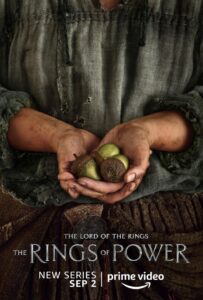
This character’s handful of cheerful acorns and their proportions in comparison to said acorns indicate that they’re most likely one of the prehistoric hobbits we’ll meet in The Rings Of Power, apparently referred to as Harfoots throughout the series to distinguish them from hobbits. The name is a bit of a cheat. “Harfoot” refers to one of the three main groups of hobbits, along with Fallohides and Stoors – Tolkien never used it as an umbrella term for hobbits in general.
That said, The Rings Of Power may focus exclusively on Harfoots because they were the first hobbits to begin moving westward from their original territories between Mirkwood and the Misty Mountains. About a thousand years into the Third Age, with Sauron gradually regaining his strength in Mirkwood, the Harfoots are believed to have crossed the Misty Mountains into the lands of Eriador where they would later establish the Shire, but Tolkien gives us one or two clues as to their whereabouts in the Second Age; namely, that they “had much to do with Dwarves in ancient times”. That’s it, really.
I’m still wary of how Amazon intends to fit hobbits into this story, seeing as it wouldn’t really make sense to push forward the date of their westward migrations, there are no other hobbit-centric stories to tell from this time period, and Tolkien seems to have been almost purposefully vague, but probably my greatest fear was that, in the interest of fan-service, Amazon would fall back on the aesthetics established for the hobbits in The Lord Of The Rings (both the book and the films).
The whimsical parodies of late 19th century British fashions, technologies, and names that we associate with the hobbits of the Shire work when the rest of Middle-earth seems only a few centuries removed by comparison, but would stick out like a sore thumb in a Second Age setting heavily inspired by Bronze and Iron Age civilizations. All of which is to say that I’m just very happy to see that Amazon is going for that ancient look with the hobbits. Not a waistcoat or pocket-watch in sight.
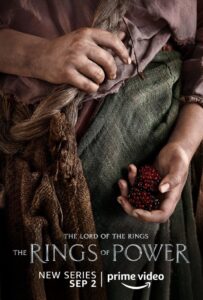
I had a hard time finding actress Markella Kavenagh in these character posters, because I was still looking out for an Elf. At the time that she was cast in The Rings Of Power, before Morfydd Clark or any other actor, her character – code-named “Tyra” – was widely believed to be Galadriel or another Elf, and many fans got the impression that she was a Silvan Elf based on audition tapes revealed in late 2019. But that was before we knew or could confirm that hobbits would be involved in the series in any capacity, and now that we do I’m locking in my guess that this is Markella Kavenagh’s “Tyra” – not an elf, but a hobbit.
In fact, let’s go back to those audition tapes for a moment. You can’t necessarily trust that the exact dialogue in these tapes is always pulled from the scripts for the show, and there’s a better than even chance that it’s not, but in one of Tyra’s audition tapes she’s seen comforting her younger sister, named “Branna”, who cries that if she “hadn’t run back from the berries we wouldn’t have lost my doll Rosie and had to come all the way out here”. This could be nothing, it might not even be a real scene from The Rings Of Power, but it’s worth noting that the character in this poster is holding some very large berries in her hand.
I’m also convinced, based on the contents of those tapes and the character breakdowns obtained by Knight Edge Media, that Tyra is the oldest daughter of two other hobbits, code-named “Hamsom” and “Cora”, whom I believe are depicted in the next two posters. Let’s move on, then, shall we?
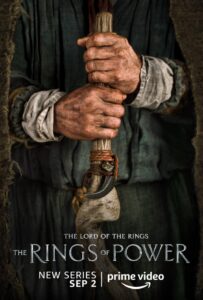
The only character in these posters who matches the description for “Hamsom”, this fellow is dressed like a hobbit, in baggy, drab-colored clothes, and his weathered hands grip the wooden hilt of a short staff topped with some kind of blunt stone instrument – which, judging by the random animal fangs attached to the hilt, has been used as a weapon in the past, perhaps to protect Hamsom’s family and “traveling community” from wolves or wargs on the road.
Only one audition tape for Hamsom was ever discovered by Redanian Intelligence. It paints a vivid picture of a character determined to stay alive through a harsh winter while battling health issues that he’s able to hide from his children, but not from his perceptive wife, who worries that she won’t be able to hold the family together without him. But the information that his wife is code-named “Cora”, and that their whole family lives a “physically demanding” nomadic lifestyle, comes from the Knight Edge Media character breakdowns.
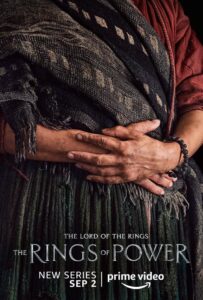
And here we have our “Cora”, most likely played by actress Thusitha Jayasundera. This poster provides very little information about her character, but we know from Knight Edge Media that “Cora” must rise to the occasion and become the matriarch of her entire family, although “the pressure of [Hamsom’s health problems] and their large family can make her seem dismissive and detached”. She is also mentioned to have at least two daughters, which is what links her to Markella Kavenagh’s Tyra, in my opinion, and implies that they’re all hobbits, even though Cora in this poster could be mistaken for a human.
Now, I want to draw your attention to the comment that Cora is a “matriarch”, because while there are very few instances of matriarchal societies or families in Middle-earth, that doesn’t mean there are none. Most notably, the family of the ancient hobbit Sméagol was “ruled by a grandmother of the folk”, according to Gandalf’s research into the subject, and she was “stern and wise in old lore”, as well as very wealthy; wealthy enough that Sméagol had come up with the lie he told Gandalf, that she had gifted him the One Ring as a birthday-present.
Sméagol was a Stoor and born roughly two-thousand, four-hundred years after the end of the Second Age, so although I’m undeniably tempted to imagine a scenario where The Rings Of Power ends on a scene of Tyra cradling baby Sméagol and calling him “her Precious”, I doubt that’s going to happen. I think this is more likely an example of Amazon’s writers building on the little information we do know about the hobbits and their ancient history to create original stories in the spirit of Tolkien’s works.
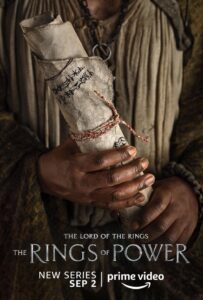
Sir Lenny Henry already confirmed a long time ago that he would play a Harfoot hobbit in The Rings Of Power, and I think you’re looking at him here – holding a piece of parchment with pictographs similar to those designed by artists John Howe and Alan Lee during their work on the Dunharrow sets in The Return Of The King, and wearing a silver ring on a necklace; which may have no significance to his character whatsoever, but certainly evokes the iconic image from Peter Jackson’s films of Frodo Baggins wearing the One Ring.
I want to mention that this is one of several posters depicting Black characters or characters of color that Amazon released, and the comments beneath every one of these posters are filled with outright racists whining about an insidious liberal conspiracy they’ve made up in their heads to explain why there are Black people – no, scratch that, hands – on their Twitter timeline. Oh, they know that Black people and people of color have always existed, but Black people and people of color in escapist fantasy is a different matter, because the genre has historically been very white and is thus seen as a last bastion for many neo-Nazis, white supremacists, and other bigots trying to fence out the world around them.
So when Black actors get cast in fantasy adaptations, it makes them really mad – because suddenly, they can’t hide there anymore. They can’t even like the original story without the caveat that they hate the adaptation for “forcing” them to see Black people in the fantasy world they thought was meant for white people only, because the story itself rarely seems to have any personal meaning to them beyond being interpreted as racist and therefore “safe”. If they no longer feel safe in this fantasy world, then they no longer feel comfortable or happy there either…and that does make me happy.
Hilariously, if these racists even took the time to check Tolkien’s own writings on the subject, they’d find that the Harfoot hobbits specifically were described as being generally “browner of skin” than Fallohides or Stoors. But I’m not gonna sit here and say that The Lord Of The Rings is perfect either. Representation is one of several areas where The Rings Of Power could actually stand to improve on the books with their cast of mostly straight white cisgender male heroes.
Dwarves
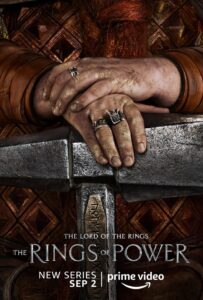
Of the twenty-three character posters released by Amazon, just two depict Dwarves…which is a bit of a shame, if you ask me. I still hope that The Rings Of Power will spend a considerable amount of time in the Dwarven kingdom of Khazad-dûm at the height of its glory (“not darksome, but full of light and splendour”, as Gimli described it in The Lord Of The Rings), but it might be through the eyes of Elven characters like Galadriel, who canonically visited Khazad-dûm several times before its gates were closed to the outside world and became a friend of the Dwarves.
Here we see a character reported by Fellowship Of Fans to be Durin (probably Durin III), played by Owain Arthur. Little is known about Durin III specifically except that, like all Dwarven kings to bear the name Durin, he would have been believed to be the reincarnation of Durin I, the eldest Father of the Dwarves. Durin III ruled Khazad-dûm during the years in which the Rings of Power were forged and the War of the Elves and Sauron was fought. He received one of the seven Rings around this time, either from Celebrimbor or Sauron – the accounts of Dwarves and Elves differ on this point, and both are biased, giving Amazon plenty of wiggle-room to tell their own story.
Whether Durin III is wearing one of the seven in this picture is unclear, as he seems to have an affinity for rings in general. I love that there’s a residue of gold-dust clinging to his hands, as if he’s been mining or perhaps just lounging amongst the treasures he’s accumulated – it could go either way. There’s something about his orange armor, coupled with the bright red braided beard, that isn’t totally working for me just yet, but I’ll need to see the full look before I can make a proper assessment. Fellowship Of Fans has reported previously that Arthur’s Durin would have “gold feet”, which is something we sadly don’t get to see in this poster.
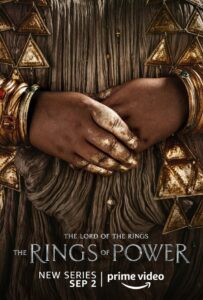
Dwarven women have only ever existed on the peripheries of Tolkien’s stories, and even in live-action adaptations (ahem, The Hobbit: An Unexpected Journey) they’ve been relegated to background characters in crowd shots. But The Rings Of Power is finally changing the narrative, with this radiant character poster promising a Dwarven queen with an actual role to play in the story, and a costume that already rivals any of those designed for Peter Jackson’s films – and we haven’t even seen it in its entirety.
Fellowship Of Fans reported yesterday that this is actress and singer Sophia Nomvete, which makes a lot of sense as the character of the Dwarven Queen is expected to sing a “sad lament” for fallen Dwarves, according to the same video linked above in which Fellowship Of Fans reported Durin III and his golden feet. Like Durin, Sophia Nomvete’s Dwarven Queen has hands stained with gold-dust. But Nomvete is by far the better-dressed of the two. She wears a jacket made of interlocking golden triangles, massive jeweled bracelets around both wrists, and there are even a couple of tiny gemstones visible within the deep folds of her tunic. She’s only missing one thing, and that is of course a long beard of her own.
It was previously reported by Fellowship Of Fans (same video, linked above) that the Dwarven women in The Rings Of Power would not have beards, but I and many others in the Tolkien community feel very strongly that Amazon has the money and resources to change that before the series releases in September and that they should. I’m prepared to forgive and even defend a lot of controversial changes and writing choices on this show, but this…this irks me. I was really looking forward to seeing all the Dwarven ladies with their beards intricately braided and adorned with precious stones.
And don’t get me wrong, I’m still very excited for Sophia Nomvete in this role, but I want to know why Amazon felt they couldn’t give the Dwarven women any beards. Not even short beards? Not even sideburns? What is this nonsense, Amazon? Explain yourself!
Others
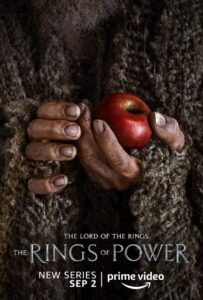
Okay, so my initial theory that this is Tom Bombadil was probably very wrong, and in retrospect makes little to no sense, but it seems I was at least correct in guessing that this character isn’t a human or a hobbit, much less an Elf or a Dwarf. According to Fellowship Of Fans, this is none other than “Meteor Man” – a nickname for an unidentified character who will appear in The Rings Of Power via meteor. I know how weird that sounds without context, so hear me out.
Fellowship Of Fans first broke the news about Meteor Man back in December of last year, but I believe we’ve known about him since 2019 – we just didn’t know we knew about him until the pieces fell into place, the same way they did with Elendil and Isildur. What we’ve known since December is that Meteor Man will fall to Middle-earth and be discovered by Harfoots, and that he suffers from amnesia and “can’t easily communicate” where he comes from, who he is, or what he’s supposed to be doing. Fellowship Of Fans reported yesterday that Meteor Man is who we see in this poster, dressed in ratty clothes and clutching an apple in one gnarled hand. Oh yeah, and he might also be evil?
Now, remember what I said about Markella Kavenagh’s “Tyra”, and how Tolkien fans including myself thought she was an Elf for a long time, before we realized she could be a hobbit? The reason we thought that was because in her very first audition tape, released way back in 2019 before we’d ever heard of Meteor Man, involved her and another character code-named “Hennah” running into a third character specifically described as “a human” on the road – like, literally running into him with their wagon – and arguing over whether to bring him back to their settlement or leave him for the bears.
At the time, I recall thinking that these two were probably Silvan Elves finding a human traveler injured in the woods, but now I can’t help but wonder if this was actually our first glimpse of Meteor Man. If you’re wondering what happens next, well, we don’t know yet because the scene ends there with Tyra saying that she “won’t leave him here”, and that somehow she can feel that “He is important”, which is more ominous with the context that this guy could be evil. For her sake, I hope that she hit him hard enough with her wagon that he completely forgot his villainous intent.
Obviously, none of this helps to answer the main question; who is Meteor Man, really? If he’s evil, that really narrows down the list of potential suspects, but Sauron canonically stayed on the surface of Middle-earth throughout the Second Age (most of his movements are actually surprisingly well-documented), and Melkor was cast into the Void at the end of the First Age, so unless this is an original character or someone totally unexpected, I don’t know what to think. Fellowship Of Fans reports that one version of the trailer for The Rings Of Power does show Meteor Man’s arrival, so hopefully we’ll get more clues before long.
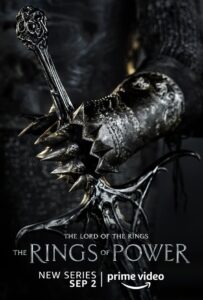
Yeah, yeah, yeah, this looks like Sauron from Peter Jackson’s movies. Except it doesn’t, and it’s not. Amazon definitely wants you to think that, make no mistake, but the similarities between this suit of armor and the one worn by Sauron in the prologue to The Fellowship Of The Ring are surface-level when you actually zoom in and compare the two.
I mean, let’s start with the weapon. Not once in six movies does Peter Jackson’s Sauron ever wield a sword. To be fair, he’s a disembodied eyeball throughout most of the saga, and therefore incapable of wielding any weapon (even his laser-eye is pretty useless), but the one time we do see him take a physical form he uses a mace – a sleek and destructive weapon with angular, yet streamlined barbs of silvery-black metal arranged around a rigid hilt. But the black sword in this picture has a sinuous, almost veiny look to it, as if it’s more liquid than metal.
Moving on to the gauntlet, note that this character’s closed fist is basically just thorns everywhere. Like, you can’t even come close to this person without getting pricked by some part of their armor. The spikes on Sauron’s gauntlets are actually relatively tiny, which makes sense seeing as he needed to be able to wear the One Ring. For whatever reason, I look at this person and my mind immediately goes to the Tomb of the Black Prince at Canterbury Cathedral, and the big impractical spikes on his knuckles (spiked armor in general tends to be impractical, but they’re also cool and this is fantasy).
Finally, although this looks like a full suit of armor from a distance, it’s actually not – they’re wearing a few bits and pieces of armor, but most of their body seems to be protected solely by chain-mail and rough fabric (note the loose strands hanging down below the wrist). For comparison, Sauron wore full-body plate armor in Fellowship Of The Ring despite being a literal Dark Lord and having nothing to worry about. So no, unless Amazon is redesigning Sauron’s armor to give him a scrappy, almost mercenary look, I don’t think this character is Sauron at all.
Fellowship Of Fans reported yesterday that this is in fact an original character named Adar, played by Joseph Mawle, and I have no reason to disagree. Adar is also a villain, according to previous reports, and he does serve under Sauron as a lieutenant throughout season one, but he is an Elf who has been corrupted – and thus, in my opinion, far more likely to carry a sword and wear lighter armor like his Elven kin.
This has nonetheless caused some concern amongst Tolkien fans that we’re going to see a known character from the First Age transformed into a Second Age villain for the purposes of the story. I can understand why that would be upsetting, but this is one of those controversial choices that I think I’ll probably end up defending, because this doesn’t sound awful to me on paper. In execution, maybe, but let’s cross that bridge when we come to it.
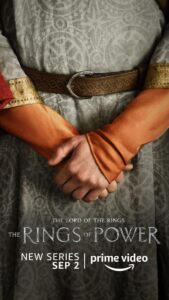
I believe the real Sauron is hiding in plain sight, disguised in the humblest of clothes and wearing not so much as a single ring to give away his true identity. This character, with their gray garments bearing the eight-pointed Star of Fëanor, who indulges in no jewelry or fancy accessories beyond a silver belt-buckle and the barely-visible edge of a red cape or cloak, absolutely screams Annatar to me – Annatar being the Elven name that Sauron took while he went undercover in Eregion as an apprentice of Celebrimbor, quietly gathering information about how to design and forge his own Ring of Power.
Maybe the Star is just a coincidence, but it’s shown up now twice in these posters. Make of that what you will. I’m calling it now, this is Sauron, and when September comes around and this character casts off their plain gray robes to reveal a terrible Dark Lord (in a parallel to Gandalf before the throne of Théoden), you will see. Either that, or this is just an Elf, in which case I never said anything about Sauron and Annatar and epic reveals.
So there you go. Twenty-three character posters, thirty-seven hands, and limitless theories. Until we get that trailer (and I hope we see it very soon), I will continue to be dissecting these posters looking for any clues I might have missed, but now I leave you to share your own thoughts, theories, and opinions, in the comments below!
